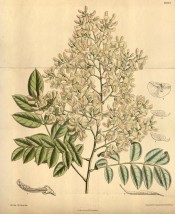Sophora japonica L.
Fully-hardy, spreading, deciduous tree with pinnate leaves, to 25cm long, composed of up to 17 lance-shaped leaflets, and terminal panicles, to 30cm long, of small, fragrant, pea-like white flowers in summer and autumn. To 30m. A number of varieties exist with variegated leaves or pendulous branches. [RHSE, Hortus, Hilliers’].
Horticultural & Botanical History
‘It appears that its buds have great importance in dyeing. The Chinese use them for pure yellow, or with the addition of indigo for one of their greens. The yellow is particularly valuable for dark orange yellow’. [Gard. Chron. 1859].
‘Sophora japonica was introduced to this country from China in 1753 by James Gordon, a nurseryman of that time at Mile End. It is not believed to be indigenous to Japan, although much cultivated there. Five trees of the original introduction were planted at Kew, one at least of which remains. The Sophora is one of the most ornamental of all hardy trees. Its foliage is elegant and richly luxuriant, and flowering as it does in September when no other large tree is in blossom, its beauty is very conspicuous. It does not as a rule flower until it is thirty to forty years old, and is always seen at its best after a hot summer.’ [BM t.8764/1918]. ABR pl.585/1809. Don.
History at Camden Park
Listed in all published catalogues [T.942/1843].
Notes
Published Dec 25, 2009 - 04:39 PM | Last updated Jul 21, 2010 - 02:31 PM
| Family | Fabaceae |
|---|---|
| Category | |
| Region of origin | China, Korea |
| Synonyms | |
| Common Name | Japanese pagoda tree, Chinese scholar tree |
| Name in the Camden Park Record |
Sophora Japonica |
| Confidence level | high |
